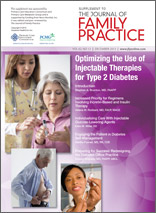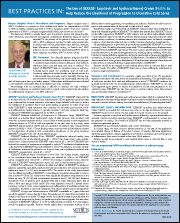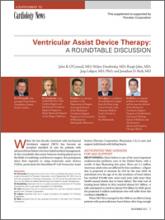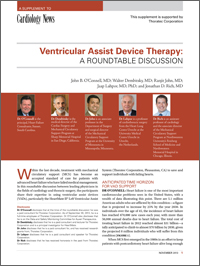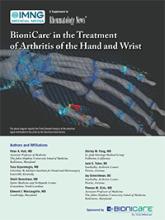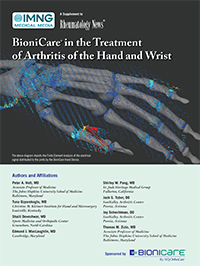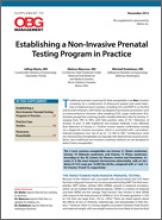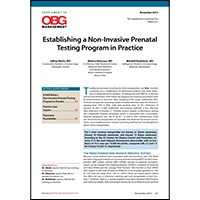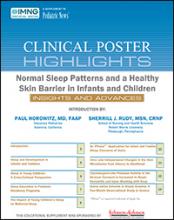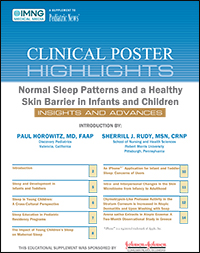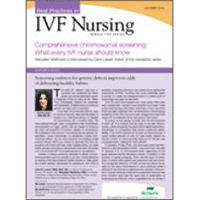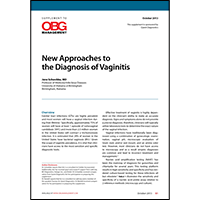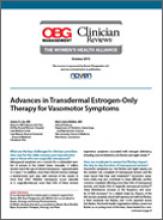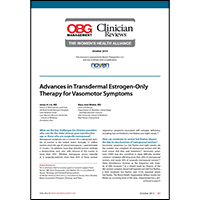User login
Optimizing the Use of Injectable Therapies for Type 2 Diabetes
BEST PRACTICES IN: The Use of XERESE® (acyclovir and hydrocortisone) Cream 5%/1% to Help Reduce the Likelihood of Progression to Ulcerative Cold Sores
Medical Education Library
A supplement to Skin & Allergy News. This supplement was sponsored by Medicis, a division of Valeant Pharmaceuticals.
- Herpes Simplex Virus-1: Prevalence and Diagnosis
- HSL Treatment
- XERESE® (acyclovir and hydrocortisone) Cream 5%/1%
- Summary and Conclusions
- INDICATION
- IMPORTANT SAFETY INFORMATION
Faculty/Faculty Disclosure
Joseph Fowler, MD
University of Louisville
Louisville, Kentucky
Dr. Fowler reported that he is a member of the speakers’ bureau for Valeant Pharmaceuticals and received compensation from Valeant for his assistance in developing the content of this article.
LINKS: Click Here for PDF.
Copyright © by Frontline Medical Communications Inc.
Medical Education Library
A supplement to Skin & Allergy News. This supplement was sponsored by Medicis, a division of Valeant Pharmaceuticals.
- Herpes Simplex Virus-1: Prevalence and Diagnosis
- HSL Treatment
- XERESE® (acyclovir and hydrocortisone) Cream 5%/1%
- Summary and Conclusions
- INDICATION
- IMPORTANT SAFETY INFORMATION
Faculty/Faculty Disclosure
Joseph Fowler, MD
University of Louisville
Louisville, Kentucky
Dr. Fowler reported that he is a member of the speakers’ bureau for Valeant Pharmaceuticals and received compensation from Valeant for his assistance in developing the content of this article.
LINKS: Click Here for PDF.
Copyright © by Frontline Medical Communications Inc.
Medical Education Library
A supplement to Skin & Allergy News. This supplement was sponsored by Medicis, a division of Valeant Pharmaceuticals.
- Herpes Simplex Virus-1: Prevalence and Diagnosis
- HSL Treatment
- XERESE® (acyclovir and hydrocortisone) Cream 5%/1%
- Summary and Conclusions
- INDICATION
- IMPORTANT SAFETY INFORMATION
Faculty/Faculty Disclosure
Joseph Fowler, MD
University of Louisville
Louisville, Kentucky
Dr. Fowler reported that he is a member of the speakers’ bureau for Valeant Pharmaceuticals and received compensation from Valeant for his assistance in developing the content of this article.
LINKS: Click Here for PDF.
Copyright © by Frontline Medical Communications Inc.
Ventricular Assist Device Therapy: A Roundtable Discussion
Topics
- Anticipated Time Horizon For VAD Support
- Incorporating VAD Implantation Earlier In Heart Failure Progression
- Support Structure For VAD Program Success
Faculty/Faculty Disclosures
John B. O’Connell, MD
Thoratec Corporation
Pleasanton, CA
Dr O’Connell discloses that at the time of the roundtable discussion he was a paid consultant for Thoratec Corporation. As of September 30, 2013, he is a full-time employee of Thoratec Corporation. Dr O’Connell also discloses that he is on the Data and Safety Monitoring Committee for Auven Therapeutics.
Walter Dembitsky, MD
Sharp Memorial Hospital
San Diego, CA
Dr Dembitsky discloses that he is a paid consultant and lecturer for, and has received research grants from, Thoratec Corporation.
Ranjit John, MD
University of Minnesota
Minneapolis, MI
Dr John discloses that he is a paid consultant for, and has received research grants from, Thoratec Corporation.
Jaap Lahpor, MD, PhD
University Medical Centre Utrecht
Utrecht, Netherlands
Dr Lahpor discloses that he is a paid consultant and speaker for Thoratec Corporation.
Jonathan D. Rich, MD
Northwestern University
Chicago, IL
Dr Rich discloses that he has received honoraria in the past from Thoratec Corporation.
Welcome to Audiocast #1 of 3. In this audiocast we will discuss the question: When you evaluate a patient for VAD therapy, what time horizon for support do you have in mind?
Welcome to Audiocast #2 of 3. In this audiocast we will answer the question: As patients are supported for longer periods of time, is trying to implant patients earlier in their heart failure progression becoming more important?
Welcome to Audiocast #3 of 3. In this audiocast we will ask the question: As more and more patients are supported for longer periods of time, what types of additional support structure will be required and how are we measuring success?
Topics
- Anticipated Time Horizon For VAD Support
- Incorporating VAD Implantation Earlier In Heart Failure Progression
- Support Structure For VAD Program Success
Faculty/Faculty Disclosures
John B. O’Connell, MD
Thoratec Corporation
Pleasanton, CA
Dr O’Connell discloses that at the time of the roundtable discussion he was a paid consultant for Thoratec Corporation. As of September 30, 2013, he is a full-time employee of Thoratec Corporation. Dr O’Connell also discloses that he is on the Data and Safety Monitoring Committee for Auven Therapeutics.
Walter Dembitsky, MD
Sharp Memorial Hospital
San Diego, CA
Dr Dembitsky discloses that he is a paid consultant and lecturer for, and has received research grants from, Thoratec Corporation.
Ranjit John, MD
University of Minnesota
Minneapolis, MI
Dr John discloses that he is a paid consultant for, and has received research grants from, Thoratec Corporation.
Jaap Lahpor, MD, PhD
University Medical Centre Utrecht
Utrecht, Netherlands
Dr Lahpor discloses that he is a paid consultant and speaker for Thoratec Corporation.
Jonathan D. Rich, MD
Northwestern University
Chicago, IL
Dr Rich discloses that he has received honoraria in the past from Thoratec Corporation.
Welcome to Audiocast #1 of 3. In this audiocast we will discuss the question: When you evaluate a patient for VAD therapy, what time horizon for support do you have in mind?
Welcome to Audiocast #2 of 3. In this audiocast we will answer the question: As patients are supported for longer periods of time, is trying to implant patients earlier in their heart failure progression becoming more important?
Welcome to Audiocast #3 of 3. In this audiocast we will ask the question: As more and more patients are supported for longer periods of time, what types of additional support structure will be required and how are we measuring success?
Topics
- Anticipated Time Horizon For VAD Support
- Incorporating VAD Implantation Earlier In Heart Failure Progression
- Support Structure For VAD Program Success
Faculty/Faculty Disclosures
John B. O’Connell, MD
Thoratec Corporation
Pleasanton, CA
Dr O’Connell discloses that at the time of the roundtable discussion he was a paid consultant for Thoratec Corporation. As of September 30, 2013, he is a full-time employee of Thoratec Corporation. Dr O’Connell also discloses that he is on the Data and Safety Monitoring Committee for Auven Therapeutics.
Walter Dembitsky, MD
Sharp Memorial Hospital
San Diego, CA
Dr Dembitsky discloses that he is a paid consultant and lecturer for, and has received research grants from, Thoratec Corporation.
Ranjit John, MD
University of Minnesota
Minneapolis, MI
Dr John discloses that he is a paid consultant for, and has received research grants from, Thoratec Corporation.
Jaap Lahpor, MD, PhD
University Medical Centre Utrecht
Utrecht, Netherlands
Dr Lahpor discloses that he is a paid consultant and speaker for Thoratec Corporation.
Jonathan D. Rich, MD
Northwestern University
Chicago, IL
Dr Rich discloses that he has received honoraria in the past from Thoratec Corporation.
Welcome to Audiocast #1 of 3. In this audiocast we will discuss the question: When you evaluate a patient for VAD therapy, what time horizon for support do you have in mind?
Welcome to Audiocast #2 of 3. In this audiocast we will answer the question: As patients are supported for longer periods of time, is trying to implant patients earlier in their heart failure progression becoming more important?
Welcome to Audiocast #3 of 3. In this audiocast we will ask the question: As more and more patients are supported for longer periods of time, what types of additional support structure will be required and how are we measuring success?
BioniCare® in the Treatment of Arthritis of the Hand and Wrist
Peter A. Holt, MD
Associate Professor of Medicine
The Johns Hopkins University School of Medicine
Baltimore, Maryland
Tuna Ozyurekoglu, MD
Christine M. Kleinert Institute for Hand and Microsurgery
Louisville, Kentucky
Shaili Deveshwar, MD
Sports Medicine and Orthopedic Center
Greensboro, North Carolina
Edmund J. MacLaughlin, MD
Cambridge, Maryland
Shirley W. Pang, MD
St. Jude Heritage Medical Group
Fullerton, California
Jack S. Tuber, DO
SunValley Arthritis Center
Peoria, Arizona
Joy Schechtman, DO
SunValley Arthritis CenterPeoria, Arizona
Thomas M. Zizic, MD
Associate Professor of Medicine
The Johns Hopkins University School of Medicine
Baltimore, Maryland
Peter A. Holt, MD
Associate Professor of Medicine
The Johns Hopkins University School of Medicine
Baltimore, Maryland
Tuna Ozyurekoglu, MD
Christine M. Kleinert Institute for Hand and Microsurgery
Louisville, Kentucky
Shaili Deveshwar, MD
Sports Medicine and Orthopedic Center
Greensboro, North Carolina
Edmund J. MacLaughlin, MD
Cambridge, Maryland
Shirley W. Pang, MD
St. Jude Heritage Medical Group
Fullerton, California
Jack S. Tuber, DO
SunValley Arthritis Center
Peoria, Arizona
Joy Schechtman, DO
SunValley Arthritis CenterPeoria, Arizona
Thomas M. Zizic, MD
Associate Professor of Medicine
The Johns Hopkins University School of Medicine
Baltimore, Maryland
Peter A. Holt, MD
Associate Professor of Medicine
The Johns Hopkins University School of Medicine
Baltimore, Maryland
Tuna Ozyurekoglu, MD
Christine M. Kleinert Institute for Hand and Microsurgery
Louisville, Kentucky
Shaili Deveshwar, MD
Sports Medicine and Orthopedic Center
Greensboro, North Carolina
Edmund J. MacLaughlin, MD
Cambridge, Maryland
Shirley W. Pang, MD
St. Jude Heritage Medical Group
Fullerton, California
Jack S. Tuber, DO
SunValley Arthritis Center
Peoria, Arizona
Joy Schechtman, DO
SunValley Arthritis CenterPeoria, Arizona
Thomas M. Zizic, MD
Associate Professor of Medicine
The Johns Hopkins University School of Medicine
Baltimore, Maryland
Establishing a Non-Invasive Prenatal Testing Program in Practice
Traditional prenatal screening for fetal aneuploidies involves screening via a combination of ultrasound analysis and serial detection of maternal serum markers, including hCG and PAPP-A, in the first and second trimesters, with follow-up diagnosis by invasive procedures such as amniocentesis or chorionic villus sampling (CVS). Large, multicenter, first-trimester prospective screening studies revealed detection rates for trisomy 21 ranging from 79% to 90%, with false positive rates of 5%.2 Detection of trisomy 18 and 13 with traditional non-invasive methods is less effective than detection of trisomy 21. Positive screens require confirmatory testing via a diagnostic invasive procedure, which is associated with a procedure-induced pregnancy loss risk of up to 1 in 300 to 500.3 Furthermore, most sex chromosome aneuploidies are typically only detected by invasive procedures, since traditional non-invasive screening methods are not designed to detect these aneuploidies.
Traditional prenatal screening for fetal aneuploidies involves screening via a combination of ultrasound analysis and serial detection of maternal serum markers, including hCG and PAPP-A, in the first and second trimesters, with follow-up diagnosis by invasive procedures such as amniocentesis or chorionic villus sampling (CVS). Large, multicenter, first-trimester prospective screening studies revealed detection rates for trisomy 21 ranging from 79% to 90%, with false positive rates of 5%.2 Detection of trisomy 18 and 13 with traditional non-invasive methods is less effective than detection of trisomy 21. Positive screens require confirmatory testing via a diagnostic invasive procedure, which is associated with a procedure-induced pregnancy loss risk of up to 1 in 300 to 500.3 Furthermore, most sex chromosome aneuploidies are typically only detected by invasive procedures, since traditional non-invasive screening methods are not designed to detect these aneuploidies.
Traditional prenatal screening for fetal aneuploidies involves screening via a combination of ultrasound analysis and serial detection of maternal serum markers, including hCG and PAPP-A, in the first and second trimesters, with follow-up diagnosis by invasive procedures such as amniocentesis or chorionic villus sampling (CVS). Large, multicenter, first-trimester prospective screening studies revealed detection rates for trisomy 21 ranging from 79% to 90%, with false positive rates of 5%.2 Detection of trisomy 18 and 13 with traditional non-invasive methods is less effective than detection of trisomy 21. Positive screens require confirmatory testing via a diagnostic invasive procedure, which is associated with a procedure-induced pregnancy loss risk of up to 1 in 300 to 500.3 Furthermore, most sex chromosome aneuploidies are typically only detected by invasive procedures, since traditional non-invasive screening methods are not designed to detect these aneuploidies.
Clinical Poster Highlights: Normal Sleep Patterns and a Healthy Skin Barrier in Infants and Children
This educational supplement to Pediatric News was sponsored by Johnson & Johnson Consumer Products Company.
Topic Highlights
- Introduction—Knowledge About Development and Maintenance of Normal Sleep and Healthy Skin in Infants and Children Continues to Evolve
- Sleep and Development in Infants and Toddlers
- Sleep in Young Children: A Cross-Cultural Perspective
- Sleep Education in Pediatric Residency Programs
- The Impact of Young Children’s Sleep on Maternal Sleep
- An iPhone® Application for Infant and Toddler Sleep: Concerns of Users
- Intra- and Interpersonal Changes in the Skin Microbiome from Infancy to Adulthood
- Chymotrypsin-Like Protease Activity in the Stratum Corneum is Increased in Atopic Dermatitis and Upon Washing with Soap
- Avena sativa Extracts in Atopic Eczema: A Two-Month Observational Study in Greece
Faculty/Faculty Disclosures
Paul Horowitz, MD, FAAP
Discovery Pediatrics
Valencia, California
Sherrill J. Rudy, MSN, CRNP
School of Nursing and Health Sciences
Robert Morris University
Pittsburgh, Pennsylvania
Dr. Horowitz discloses that he is a paid consultant and Advisory Board member to Johnson & Johnson Consumer Companies, Inc.
Ms. Rudy discloses that she is a paid consultant to Johnson & Johnson Consumer Companies, Inc.
This educational supplement to Pediatric News was sponsored by Johnson & Johnson Consumer Products Company.
Topic Highlights
- Introduction—Knowledge About Development and Maintenance of Normal Sleep and Healthy Skin in Infants and Children Continues to Evolve
- Sleep and Development in Infants and Toddlers
- Sleep in Young Children: A Cross-Cultural Perspective
- Sleep Education in Pediatric Residency Programs
- The Impact of Young Children’s Sleep on Maternal Sleep
- An iPhone® Application for Infant and Toddler Sleep: Concerns of Users
- Intra- and Interpersonal Changes in the Skin Microbiome from Infancy to Adulthood
- Chymotrypsin-Like Protease Activity in the Stratum Corneum is Increased in Atopic Dermatitis and Upon Washing with Soap
- Avena sativa Extracts in Atopic Eczema: A Two-Month Observational Study in Greece
Faculty/Faculty Disclosures
Paul Horowitz, MD, FAAP
Discovery Pediatrics
Valencia, California
Sherrill J. Rudy, MSN, CRNP
School of Nursing and Health Sciences
Robert Morris University
Pittsburgh, Pennsylvania
Dr. Horowitz discloses that he is a paid consultant and Advisory Board member to Johnson & Johnson Consumer Companies, Inc.
Ms. Rudy discloses that she is a paid consultant to Johnson & Johnson Consumer Companies, Inc.
This educational supplement to Pediatric News was sponsored by Johnson & Johnson Consumer Products Company.
Topic Highlights
- Introduction—Knowledge About Development and Maintenance of Normal Sleep and Healthy Skin in Infants and Children Continues to Evolve
- Sleep and Development in Infants and Toddlers
- Sleep in Young Children: A Cross-Cultural Perspective
- Sleep Education in Pediatric Residency Programs
- The Impact of Young Children’s Sleep on Maternal Sleep
- An iPhone® Application for Infant and Toddler Sleep: Concerns of Users
- Intra- and Interpersonal Changes in the Skin Microbiome from Infancy to Adulthood
- Chymotrypsin-Like Protease Activity in the Stratum Corneum is Increased in Atopic Dermatitis and Upon Washing with Soap
- Avena sativa Extracts in Atopic Eczema: A Two-Month Observational Study in Greece
Faculty/Faculty Disclosures
Paul Horowitz, MD, FAAP
Discovery Pediatrics
Valencia, California
Sherrill J. Rudy, MSN, CRNP
School of Nursing and Health Sciences
Robert Morris University
Pittsburgh, Pennsylvania
Dr. Horowitz discloses that he is a paid consultant and Advisory Board member to Johnson & Johnson Consumer Companies, Inc.
Ms. Rudy discloses that she is a paid consultant to Johnson & Johnson Consumer Companies, Inc.
Best Practices in IVF Nursing: Comprehensive chromosomal screening: What every IVF nurse should know
New Approaches to the Diagnosis of Vaginitis
Genital tract infections (GTIs) are highly prevalent and most women will have a vaginal infection during their lifetime.1 Specifically, approximately 75% of women will have at least 1 episode of vulvovaginal candidiasis (VVC) and more than 2.3 million women in the United States will contract a trichomoniasis infection. It is estimated that 29% of women in the United States have bacterial vaginosis (BV).2 Given the scope of vaginitis prevalence, it is vital that clinicians have access to the most sensitive and specific diagnostic tools.
Effective treatment of vaginitis is highly dependent on the clinician’s ability to make an accurate diagnosis. Signs and symptoms alone do not provide a precise diagnosis; therefore, clinicians will typically utilize laboratory tests to determine the exact nature of the vaginal infection.
Vaginal infections have traditionally been diagnosed using a combination of gynecologic examination, vaginal pH, microscopic evaluation of Gram stain and/or wet mount, and an amine odor test. However, most clinicians do not have access
to microscopy and as a result empiric diagnoses are common and lead to incorrect treatment and management.3
Nucleic acid amplification testing (NAAT) has been the mainstay of diagnosis for gonorrhea and chlamydia for several years. This testing platform results in high sensitivity and specificity and has rendered culture-based testing for these infections all but obsolete.4 Table 1 illustrates the sensitivity and specificity of a nucleic acid probe assay relative to 2 reference methods (microscopy and culture).
Nucleic acid amplification tests are designed to target the microorganisms that are most likely causing vaginal symptoms. Targeted testing is the most clinically appropriate testing choice for women with high-risk histories or symptoms as shown in Table 2.
This supplement will address some of the more prevalent GTIs that may develop in women. While many of the following infections are associated with signs and symptoms, affected patients are just as often asymptomatic. Moreover, many signs and symptoms of some GTIs can overlap those of other GTIs, confounding diagnosis based simply on signs and symptoms.
Genital tract infections (GTIs) are highly prevalent and most women will have a vaginal infection during their lifetime.1 Specifically, approximately 75% of women will have at least 1 episode of vulvovaginal candidiasis (VVC) and more than 2.3 million women in the United States will contract a trichomoniasis infection. It is estimated that 29% of women in the United States have bacterial vaginosis (BV).2 Given the scope of vaginitis prevalence, it is vital that clinicians have access to the most sensitive and specific diagnostic tools.
Effective treatment of vaginitis is highly dependent on the clinician’s ability to make an accurate diagnosis. Signs and symptoms alone do not provide a precise diagnosis; therefore, clinicians will typically utilize laboratory tests to determine the exact nature of the vaginal infection.
Vaginal infections have traditionally been diagnosed using a combination of gynecologic examination, vaginal pH, microscopic evaluation of Gram stain and/or wet mount, and an amine odor test. However, most clinicians do not have access
to microscopy and as a result empiric diagnoses are common and lead to incorrect treatment and management.3
Nucleic acid amplification testing (NAAT) has been the mainstay of diagnosis for gonorrhea and chlamydia for several years. This testing platform results in high sensitivity and specificity and has rendered culture-based testing for these infections all but obsolete.4 Table 1 illustrates the sensitivity and specificity of a nucleic acid probe assay relative to 2 reference methods (microscopy and culture).
Nucleic acid amplification tests are designed to target the microorganisms that are most likely causing vaginal symptoms. Targeted testing is the most clinically appropriate testing choice for women with high-risk histories or symptoms as shown in Table 2.
This supplement will address some of the more prevalent GTIs that may develop in women. While many of the following infections are associated with signs and symptoms, affected patients are just as often asymptomatic. Moreover, many signs and symptoms of some GTIs can overlap those of other GTIs, confounding diagnosis based simply on signs and symptoms.
Genital tract infections (GTIs) are highly prevalent and most women will have a vaginal infection during their lifetime.1 Specifically, approximately 75% of women will have at least 1 episode of vulvovaginal candidiasis (VVC) and more than 2.3 million women in the United States will contract a trichomoniasis infection. It is estimated that 29% of women in the United States have bacterial vaginosis (BV).2 Given the scope of vaginitis prevalence, it is vital that clinicians have access to the most sensitive and specific diagnostic tools.
Effective treatment of vaginitis is highly dependent on the clinician’s ability to make an accurate diagnosis. Signs and symptoms alone do not provide a precise diagnosis; therefore, clinicians will typically utilize laboratory tests to determine the exact nature of the vaginal infection.
Vaginal infections have traditionally been diagnosed using a combination of gynecologic examination, vaginal pH, microscopic evaluation of Gram stain and/or wet mount, and an amine odor test. However, most clinicians do not have access
to microscopy and as a result empiric diagnoses are common and lead to incorrect treatment and management.3
Nucleic acid amplification testing (NAAT) has been the mainstay of diagnosis for gonorrhea and chlamydia for several years. This testing platform results in high sensitivity and specificity and has rendered culture-based testing for these infections all but obsolete.4 Table 1 illustrates the sensitivity and specificity of a nucleic acid probe assay relative to 2 reference methods (microscopy and culture).
Nucleic acid amplification tests are designed to target the microorganisms that are most likely causing vaginal symptoms. Targeted testing is the most clinically appropriate testing choice for women with high-risk histories or symptoms as shown in Table 2.
This supplement will address some of the more prevalent GTIs that may develop in women. While many of the following infections are associated with signs and symptoms, affected patients are just as often asymptomatic. Moreover, many signs and symptoms of some GTIs can overlap those of other GTIs, confounding diagnosis based simply on signs and symptoms.
Advances in Transdermal Estrogen-Only Therapy for Vasomotor Symptoms
What are the key challenges for clinician providers who care for the older woman past reproductive age or those who are surgically menopausal? Menopausal symptoms are a concern for a substantial number of women in the United States. Annually, 11 million women reach the age of natural menopause—approximately 51.3 years.1,2 In addition, more than 500,000 women undergo a hysterectomy each year, with removal of the ovaries in more than 50%.3 Whether menopause occurs naturally or is surgically-induced, more than 85% of these women experience symptoms associated with estrogen deficiency, including, but not limited to, hot flushes and night sweats.4,5
What are the key challenges for clinician providers who care for the older woman past reproductive age or those who are surgically menopausal? Menopausal symptoms are a concern for a substantial number of women in the United States. Annually, 11 million women reach the age of natural menopause—approximately 51.3 years.1,2 In addition, more than 500,000 women undergo a hysterectomy each year, with removal of the ovaries in more than 50%.3 Whether menopause occurs naturally or is surgically-induced, more than 85% of these women experience symptoms associated with estrogen deficiency, including, but not limited to, hot flushes and night sweats.4,5
What are the key challenges for clinician providers who care for the older woman past reproductive age or those who are surgically menopausal? Menopausal symptoms are a concern for a substantial number of women in the United States. Annually, 11 million women reach the age of natural menopause—approximately 51.3 years.1,2 In addition, more than 500,000 women undergo a hysterectomy each year, with removal of the ovaries in more than 50%.3 Whether menopause occurs naturally or is surgically-induced, more than 85% of these women experience symptoms associated with estrogen deficiency, including, but not limited to, hot flushes and night sweats.4,5

